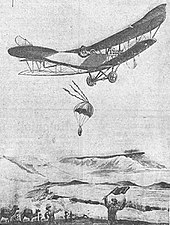German-South West African Aviation Association

The German South West African Aviation Association was an association to promote aviation and airship travel in the so-called protected areas of the German Empire , especially in German South West Africa .
founding
The association was formed in Keetmanshoop at the beginning of May 1912 , initially under the name of South West African Air Fleet Association . On May 4th the statutes were passed. At the time it was founded, the association had around 60 members. Every German in possession of civil rights could be accepted. Non-German Europeans could get an extraordinary membership. On May 11, 1912, the name was changed to German-South West African Aviation Association . The annual fee was 10 marks .
The first chairman of the association was the lawyer and notary Otto Forkel , who after 1903 was a judge and representative of the regional council in the Keetmanshoop district. The second chairman was the first lieutenant of the Schutztruppe Eckhard Berlin , who himself had an aircraft license.
Advertising for German colonial aviation
On June 6, 1912, the association's executive committee divided German South West Africa into four areas that were subordinate to certain association members. In addition, letters were drawn up in the other protected areas of the German Reich to promote German colonial aviation elsewhere. The long-term goal was to create an aviation organization for all German protected areas.
In July 1912 a call to the Germans in South West Africa was published, in which aviation was advertised as a technical advance and national cultural promotion and the formation of local groups was encouraged. The number of members rose to around 800, who regularly received the club magazine Die Luftflotte .
At the end of 1912, the association developed guidelines for the future development of aviation, which were handed over to the governor of German South West Africa, Theodor Seitz . The elaboration comes to the conclusion that aircraft are useful in the event of a war in the colonies. Aircraft could operate unnoticed and cause serious damage to the enemy. The protection force therefore needs aircraft for reconnaissance and attack purposes, as well as maps, fuel, personnel and finances. The German Reich should not fall behind the other world powers, it should strengthen the national feeling in this regard. Neither the air sport nor the transport sector received special mention.
Governor Seitz and the commandant of the protection force Joachim von Heydebreck were open-minded, but referred to the lack of budget funds from the Reich Colonial Office . Von Heydebreck only arranged for wind measurements, which showed that aviation could in principle also be carried out under African weather conditions.
The association also submitted a petition to the German Reichstag in which it demanded a fleet of aircraft and airships for the protected areas along with the necessary financial resources. In April 1913, the Regional Council of German South West Africa openly supported the association's demands and advocated consideration in the military budget. The German Colonial Society joined in in July 1913 : Funding was needed to be able to begin immediately with the development of land and seaplanes in the larger African protected areas.
With the help of money from the national flight donation and the growing interest of the young aviation industry, it was finally possible at the end of 1913 to obtain the necessary funds.
Development and end of aviation in German South West Africa
In order to create suitable take-off and landing sites, airfields were marked out at several locations in the protected area , which were often not much more than areas cleared of vegetation . The German-Southwest African Aviation Association provided support in the search for and preparation of the places with its local knowledge.
In May and June 1914 a total of three aircraft arrived in Swakopmund by ship . It was an aviation and a Roland arrow double-decker from LFG , which were stationed on the traffic trains of the protection force in Karibib and Keetmanshoop. With the third aircraft, a Pfalz double-decker with a pusher propeller , the pilot Bruno Büchner undertook postal and inspection flights on a private initiative, before he embarked with his aircraft on to German East Africa .
The other two aircraft were used for reconnaissance flights and bombing of enemy troop camps in South West Africa during World War I until they were badly damaged in unsuccessful take-off attempts in April and May 1915.
The surrender of the protection force of German South West Africa in July 1915 and the Versailles Peace Treaty in 1919 also marked the end of German colonial aviation in the former protected areas.
Air sports, for example in the form of gliding , became a club activity for the German-born residents of South West Africa in the interwar period .
Local groups
Local groups were formed in the following places from 1912 to 1914:
- Gibeon
- Grootfontein-North
- Caribib
- Keetmanshoop
- Kolmanskop
- Lüderitz Bay
- Okahandja
- Omaruru
- Swakopmund
- Warm bath
- Windhoek
gallery
Remarks
- ↑ When it was founded, the name of the club was also spelled Deutsch-Südwest Afrikanischer Luftfahrerverein
Web links
literature
- Karl-Dieter Seifert: German aviators over the colonies . Zweibrücken: VDM Heinz Nickel, 2007. ISBN 978-3-86619-019-1 .



